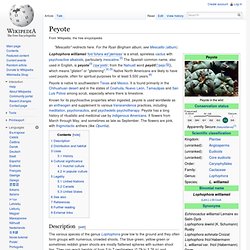

Native American Peyote Music. Peyote. Lophophora williamsii /loʊˈfɒfərə wɪlˈjæmsiaɪ/ is a small, spineless cactus with psychoactive alkaloids, particularly mescaline.[2] The Spanish common name, also used in English, is peyote[3] (/pəˈjoʊti/; from the Nahuatl word peyōtl [ˈpejoːt͡ɬ]), which means "glisten" or "glistening".[4] [5] Native North Americans are likely to have used peyote, often for spiritual purposes for at least 5,500 years.[6] Peyote is native to southwestern Texas and Mexico.

It is found primarily in the Chihuahuan desert and in the states of Coahuila, Nuevo León, Tamaulipas and San Luis Potosi among scrub, especially where there is limestone. Description[edit] Lophophora williamsii with small, red fruit The various species of the genus Lophophora grow low to the ground and they often form groups with numerous, crowded shoots. Lophophora williamsii seedling at roughly 1 1/2 months of age The cactus produces flowers sporadically; these are followed by small edible pink fruit. Sacred and Medicinal Cacti: Peyote, San Pedro and other Ethnopharma. All rights reserved. Not to be printed or copied and distributed for personal, commercial, and/or financial gain, in print or electronically, without the expressed written consent of the author. The present edition is authorized for use only by The Cactus and Succulent Plant Mall at All correspondence can be directed to: Michael S.
Smith at msscacti@yahoo.com Cover photo: Trichocereus peruvianus Michael S. For my wife, JLS, for her eternal patience. Disclaimer The following material is for informational and educational purposes only. Acknowledgements I would like to sincerely thank all those individuals who have taken the time to assist me in this endeavor by offering their informative knowledge, comments, thoughts, and suggestions; they are many, this is the product. Table of Contents Introduction Introduction Though many cactus species are known as forms of peyote not all have a recorded history of ethnobotanical use. Michael S. Peyote. Peyote (Lophophora williamsii) Main Page. Peyote is Schedule I in the United States.

This means it is illegal to manufacture, buy, possess, or distribute without a DEA license, unless it is being used as part of “bonafide religious ceremonies” as per 42 USC §1996a. Addictive Potential: None Emergency Room Visits Yearly: Unknown Mandatory Minimum Sentence: Unknown Mechanism of Action: The primary active constituent, Mescaline, binds to and activates the serotonin 5-HT(2A) receptor Overview: Peyote (Lophophora williamsii) is a hallucinogen that is traditionally dried and eaten in a ritual setting to induce spiritual and/or visionary experiences. Peyote is a small button shaped cactus 2-5 inches in diameter, which contains the hallucinogen mescaline (3,4,5-trimethoxyphenethylamine) and grows in Mexico and the Southwest United States.
Peyote has been used as a spiritual tool to aid people in consciousness exploration for thousands of years. Side Effects and Adverse Reactions: Deaths and Overdoses: Peyote (also Lophophora williamsii) Main Index. Growing Lophophora williamsii - Peyote. Growing Lophophora williamsii Peyote Natural Growing Conditions Peyote is a slow growing, spineless cacti, native to Central Mexico and Texas.
It grows in many areas throughout the Chihuahuan Desert, but is becoming scarce due to overharvesting. Although the areas it is commonly found in are usually very dry and receive much harsh direct sunlight, the cactus itself often grows in the shade of another cactus or nearby shrub. Growing from Seed Like most cacti, Peyote is fairly simple to propagate from seed, although it may take anything from three days to a year for seeds to germinate.
Please see the Growing Cacti form Seed technique. Trout suggests putting lumps of limestone next to small Peyote plants to provide shading from direct sun. Grafting Due to it's naturally slow growth rate, some growers prefer to graft Peyote onto faster growing species to cut down on the time it takes to produce fully grown plants. As with all cacti, never graft Peyote just for the sake of it. Soil Mixtures. Experience Vaults: Peyote - The Plant with the Answer. I am a male (vintage hippy) who has had a fair share of psychadelic experiences in my time.

None, however could equal up to the life-changing trip I experienced after ingesting 'the divine catus'. It was saturday in El Paso,Texas. I was out of the house by 6 o'clock looking for my well known friend, lysergic acid diethylamide. Now up until this point I had never had a problem finding acid. But this time would be different. I was very dissapointed to hear that I had not succeeded in my journey for a dose. Of course, being the desperate bastard i was at that point in time, I anxiously begged him to 'hook me up' with peyote. 'Hop in.' I quickly jumped in the vintage 1971 volkswagen van. When we arrived, I was surprised (but rather excited) to walk into an adobe-style house full of native americans. Ok. Probably an hour after ingestion, the nausea was extreme. After about 30 miutes of hiking (the time now being about 10:30 P.M.), I stopped at my destination.